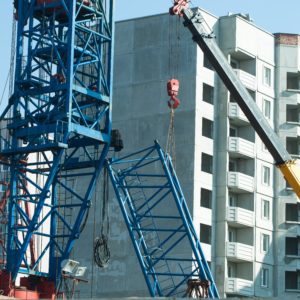Div 43 is about the deprecation of buildings and structural improvements.
Division 43
The deductions under Div 43 make up the bulk of a property investors deductions. And the good news is that the changes to Div 40 don’t affect Div 43.
s8-1 (2) ITAA97
The depreciation of capital works starts with a clear No as in N-O in s8-1 ITAA 97.
s8-1 (2): …you cannot deduct a loss or outgoing … to the extent that: (a) it is a loss or outgoing of capital, or of a capital nature…
But there are two exceptions. And those two sit in Div 40 and 43. Div 40 we covered in article 72. So let’s focus on Div 43 here.
Division 43
Div 43 allows a deduction for two types of capital works – buildings and structural improvements. And these will often result in substantial deductions. This is where the money in.
Buildings
Buildings are straight forward. A building is a building.
(1) This Division applies to capital works being a building, or an extension, alteration or improvement to a building:
(a) begun in Australia after 21 August 1979; or
(b) begun outside Australia after 21 August 1990.
Structural Improvements
At the start it was just buildings. But then from 26 February 1992 structural improvements came in.
s43-20 (2): This Division also applies to capital works … begun after 26 February 1992 that are structural improvements, or extensions, alterations or improvements to structural improvements, whether they are in or outside Australia.
Structural improvements get a lot more air time in Div 43. There is a list of examples.
s43-20 (3): Some examples of structural improvements are:
(a) sealed roads, sealed driveways, sealed car parks, sealed airport runways, bridges, pipelines, lined road tunnels, retaining walls, fences, concrete or rock dams and artificial sports fields; and
(b) earthworks that are integral to the construction of a structural improvement …, for example, embankments, culverts and tunnels associated with a runway, road or railway.
And then there is an exclusion of specific earthworks. Earthworks not integral to a structure don’t qualify for a deduction.
s43-20 (4): This Division does not apply to structural improvements being:
(a) earthworks that:
(i) are not integral to the installation or construction of a structure; and
(ii) are permanent (assuming they are maintained in reasonably good order and condition); and
(iii) can be economically maintained in reasonably good order and condition for an indefinite period;
for example, unlined channels, unlined basins, earth tanks and dirt tracks; or
(b) earthworks that merely create artificial landscapes, for example, grass golf course fairways and greens, gardens, and grass sports fields.
So building the foundations of a house qualifies for a deduction. Building an underground water tank might not.
There is more in subsection 5 about environment protection earthworks, but we will spare you the details for now.
Percentage
The deduction is either 2.5% of the construction expenditure over 40 years. Or it is 4% over 25 years. But neither commences until construction reaches completion: s43-30.
The rate that applies (2.5% or 4%) depends on the date construction commenced. And it depends on the type of construction expenditure incurred.
The rules in s 43-145, and s 43-200 to 43-220 for determining the rate are complex. But to give you one example. The 2.5% rate applies to capital expenditure incurred on the construction of a residential rental property that commenced after 26 February 1992.
Expenditure
Construction expenditure is capital expenditure incurred to construct capital works. It does not include capital expenditure on acquiring land, demolishing existing structures, landscaping or plant; s 43-70.
Therefore, capital allowance deductions for expenditure on buildings or structural improvements that are also regarded as ‘plant’ are generally provided for under Div 40 and not Div 43.
This is notwithstanding the rule in s 40-45 (2) about the general priority given to Div 43 over Div 40 expenditure.
Definition of Plant
There is a statutory definition of plant in s 45-40. Plant includes articles, machinery, tools, fences for farming operations, and other assets.
This s 45-40 plant definition is an inclusive definition. That means that other amounts can also be plant which are not provided for in the section.
For example, capital expenditure or buildings or structural improvements that also satisfies the case law meaning of plant is likely to be deducted under the UCA provisions in Div 40 and not Div 43.
Subsequent Owners
A taxpayer may incur Div 43 construction expenditure and subsequently sell the capital works to an entity that uses the capital works to produce assessable income.
For example, the original owner builds a house on land in 1994 which they subsequently sell to a purchaser who uses the house as a rental property.
The subsequent owner may claim a capital works deduction under Div43 over the remaining 25- or 40- year period (as applicable) based on the original construction expenditure.
s43-15 (1): The amount you can deduct is a portion of your construction expenditure. However, it cannot exceed the amount of undeducted construction expenditure….
If the subsequent owner can not obtain the original construction costs, they may need to engage the services of a quantity surveyor or another independent qualified person.
Example
Bill constructed a residential property and paid $1m on 1 July 2010 upon completion. On 1 July 2020, Bob purchased the property for $2m and rented it out to a tenant.
If Bob continues to rent the property out, he can claim a Div 43 deduction. The deduction comprises of the $1m original construction expenditure at rate of 2.5% for 40 years until 30 September 2050.
MORE
Disclaimer: Tax Talks does not provide financial or tax advice. All information on Tax Talks is of a general nature only and might no longer be up to date or correct. You should seek professional accredited tax and financial advice when considering whether the information is suitable to your or your client’s circumstances.
Last Updated on 14 January 2019



